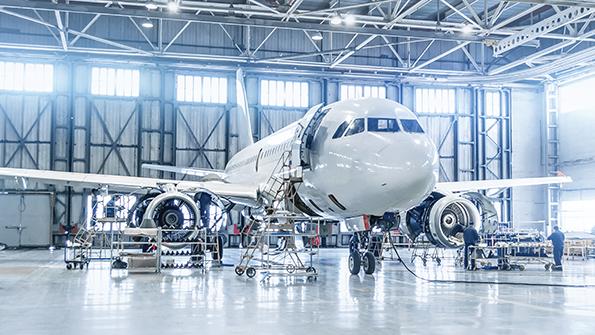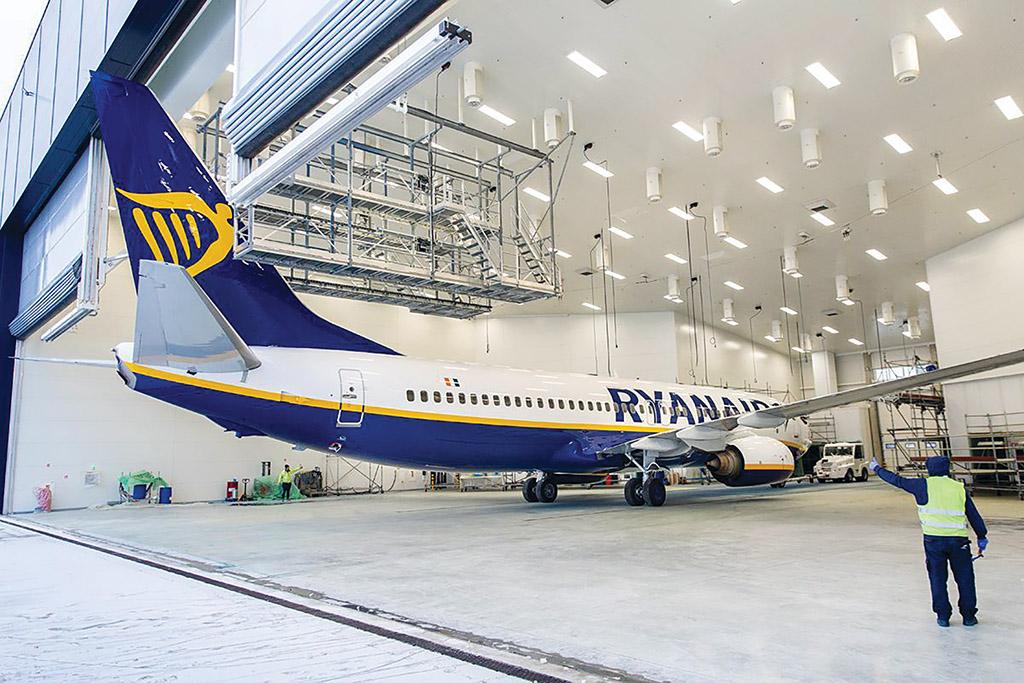
Adjusting Strategies
Eastern Europe’s MRO segment is expected to take longer to recover than neighboring regions, but its aftermarket players are fine-tuning some of their capabilities and services to ride out the downturn.
Alevtina Fursayeva, executive director at Ukraine-based ABC Management, which assists with European Union Aviation Safety Agency-certified training, predicts that region’s aviation recovery will be slower than for its Western European neighbors due in part to the slow vaccination progress. “Lots of people are [pinning] their plans and hopes [on] vaccinations, which will mean more air travel, but realistically experts expect a full recovery by as late as 2026 or 2027,” she says. “The pessimistic scenario is that it could take up to 10 years to get back to pre-COVID-19 [traffic] levels.”
Despite existing issues, MRO providers are focusing on adjusting their capabilities in order to navigate the remainder of the pandemic. These include the Avia Prime Group, which owns Adria Tehnika and Linetech. “Right now, we are trying to focus on the cargo operators and the lessors because they operated quite well during the COVID-19 time,” says Piotr Kaczor, the group’s CEO.

In the long term, Kaczor does not foresee any major strategy changes but says the group has increased its focus on component maintenance. “It can give us some extra work and revenue and workforce stability,” he says.
At the height of the crisis, Estonia-based Magnetic MRO laid off 20% of its staff while 20-30% of revenues “evaporated,” mainly from the non-labor business, says Risto Maeots, CEO of Magnetic MRO.
Despite these challenges, Maeots says the crisis gave the company “a kick” start into certain activities, and it focused some of its investment in two parts of the business specifically. “We didn’t start this from scratch but saw some of the business sectors picking up faster, such as our engine business where we carry out case repairs and hospital visits. This was due to more lease returns happening after airlines had to return aircraft.”
FL Technics CEO Zilvinas Lapinskas says his company, like Magnetic MRO, is also seeing some rebound in demand for engine services. The company opened FL Technics Engine Services last year in Kaunas, Lithuania, focusing on engine repairs. “The first engines are coming in for repairs soon,” he says, but he anticipates it will take some time to gain more market share in the region due to competition.
Lapinskas credits the company’s decision to diversify its MRO portfolio several years ago following the bankruptcy of its biggest customer, Transaero, as a reason business has remained relatively stable in such a challenging period.
Now it is looking at different engine types. “We are investing money into engines, doing teardowns of engines and buying new types of engines—we’ve just sold a Pratt & Whitney engine for a Boeing 747 cargo aircraft. Before that, we were mostly focused on CFM56 engines,” he says.
The Role Of Independents
The events of the past year have led to questions about the changing role of independent MROs in the aftermarket post-crisis and whether more consolidation and partnerships are on the horizon.
“To be able to invest and grow in a new region [requires] maintenance capabilities and facilities—companies are more likely to do this with a partner,” says Sercan Toper, senior vice president of Turkish Technic. “Joint ventures with OEMs are likely to rise, as it’s generally a good idea to partner with them,” he adds. Toper also notes the vibrant merger and acquisition activity that has occurred in the aftermarket over the past five years and says joint ventures have been important for companies seeking capability growth.
Fraser Currie, chief commercial officer at Joramco, based in Jordan but with customers in the Baltics, Eastern Europe and Russia (BEER) region, agrees with Toper’s observation about more joint ventures and alliances being formed. “The pandemic has taught us that yet again cash is king, and cash flow is critical to the survivability through these periods,” he says. However, given the belief that the landscape has permanently changed as a result of the crisis, Currie says companies looking to invest in areas such as new capabilities and hangar space will have to do that in a more “sure-footed” manner.
Overall, there will be more market consolidation involving independent MROs, Currie expects. “I don’t see airlines returning to their own in-house MRO capability, and I see alliances forming particularly for new facilities and aligning on where their capabilities give strength,” he says. Currie says more airlines would rather go to an MRO alliance than two separate independent MROs, which could involve challenges like dealing with different interface documents and potentially different customer engagement practices.
In agreement on the consolidation topic is Richard Marston, director of customer service, marketing and sales for Europe, the Middle East and Africa at MAAS Aviation, which operates 11 facilities worldwide. “There are consolidations taking place, and there will be more, certainly with airlines, which will drive more work in MRO for us,” Marston says. “Our long-term strategy is based around partnerships and working with various partners around the globe.”
The company opened its new Kaunas painting hangar in early 2021, which Marston says is based on a partnership model with FL Technics. “Customers want a one-stop shop,” he says. “We wanted to target new customers—leasing customers want maintenance and painting in one location, so [we were] trying to open up a new market area. . . . We were strong with airlines but maybe not with leasing companies.”
Ready For a Parts Demand Uptick
Demand for used serviceable materials is expected to increase post-crisis, particularly from airlines looking to tap into cost savings. This will be no different in Eastern Europe, with the market showing small signs of recovery following a slump in parts demand at the height of the crisis.
Jasper van den Boogaard, vice president for airframe acquisition and trading at APOC Aviation—which during the crisis welcomed a new investor in Dutch private equity firm Egeria—actively bought assets related to the Airbus A320 and Boeing 737-family aircraft. “We tried to restock our inventory to be ready for the recovery,” he says. “We looked at much younger aircraft because those are the ones that’ll be the first to return to service.”
Eigirdas Keblikas, vice president for Asset Trading and Leasing at Magnetic MRO, says the Estonian MRO finished its last aircraft teardown in 2019 and the year before tore down six engines. “We managed to sell most of the stock before COVID-19 hit,” he says. But due to a downturn in demand for components such as wheels and brakes and avionics, Keblikas says the company altered its strategy to focus on the asset side while lowering component volumes. “We haven’t done any teardowns in the past year, but we’ve acquired several landing gears and engines,” he says.
Keblikas highlights wheels and brakes as components seeing the biggest price fluctuations in the current climate. He notes price drops of as much as 50% compared to three years ago. “There is still demand, but [it is] much lower due to the lower volume of flights,” he says, adding that there has also been a decrease in demand for auxiliary power units.
Following the slump in components demand in 2020, Keblikas says there are already signs of recovery this year. Over the next 1-2 years, he says Magnetic MRO will look at purchasing parts and investigate fresh teardown projects. “Then is the time to purchase, because if you purchase too early, it requires a lot of investment . . . but if you wait longer, you might overpay for the material compared to the current market price,” he adds.
Slightly less positive about the recovery is Lee Whitehurst, commercial director for materials at GE Aviation. “We are starting to see things pick up, but from an output perspective, we’ve seen everybody deferring maintenance,” he says. Throughout last year, Whitehurst says he had never bought so many engines. “This is good from a supply perspective, but I’d have rather not [seen] them. As the OEM, our priority is to keep the engine flying, and for me to buy one for part-out is a last resort.”
However, he says GE Aviation intends to grow its Central and Eastern European presence in countries like Hungary, where it already employs 4,000 staff at operations such as its center of excellence for high-technology repairs. “We really see Eastern Europe developing like the Middle East, and we are going to grow our footprint there,” Whitehurst says.
Armando Filho, director of material management at Vallair, sees a mixed picture. While the company saw other revenue streams emerge last year, such as A321 passenger-to-freighter conversion work, component sales were down. He notes that the last two months have produced some “good results,” albeit still far from what was previously forecast. “We need to adapt, be flexible and look for alternatives to support customers,” he says, adding that he foresees more parts exchange and leases going forward.
